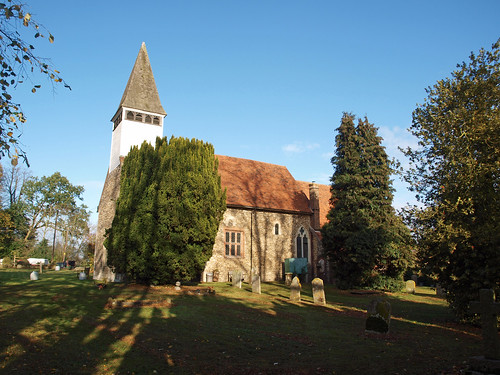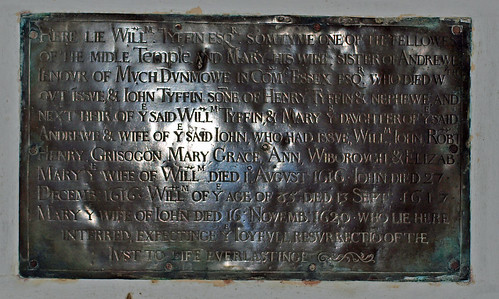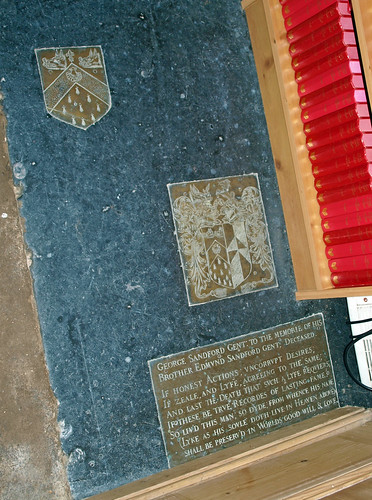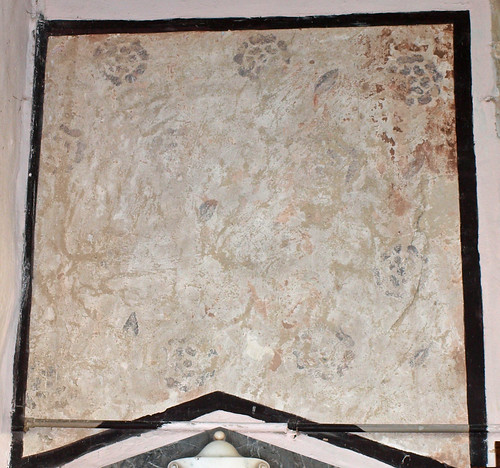All Saints is normally locked without a keyholder listed but when I visited a couple of guys were maintaining the churchyard and one offered to fetch the key. Initially I said no but then reconsidered and accepted his offer.
On balance I'm glad I did as I saw an otherwise inaccessible interior but it was all rather dull apart from some nice brass work.
I'm on record expressing my dislike of this architectural style and I think All Saints shows why.
ALL SAINTS. Nave, lower chancel, and belfry. Norman windows in the N and S walls, plain Norman S doorway, Norman N doorway with one order of one-scallop capitals and a roll-moulding. The chancel walls are partly so thick that they must have carried a crossing tower. In the N and S walls one Dec window each, in the S wall in addition one early C16 three-light brick window. The belfry rests on four posts in a row from N to S with cross-beam and arched braces and a tiebeam a little further E, also with arched braces. Between the four posts a SCREEN was put up in 1920 as a war memorial, an unusual and very successful design. - FONT. Octagonal, late C12, with three shallow blank arches on each side of the bowl. - PLATE. Good Cup of 1702.
ALL SAINTS. Nave, lower chancel, and belfry. Norman windows in the N and S walls, plain Norman S doorway, Norman N doorway with one order of one-scallop capitals and a roll-moulding. The chancel walls are partly so thick that they must have carried a crossing tower. In the N and S walls one Dec window each, in the S wall in addition one early C16 three-light brick window. The belfry rests on four posts in a row from N to S with cross-beam and arched braces and a tiebeam a little further E, also with arched braces. Between the four posts a SCREEN was put up in 1920 as a war memorial, an unusual and very successful design. - FONT. Octagonal, late C12, with three shallow blank arches on each side of the bowl. - PLATE. Good Cup of 1702.
WAKES COLNE. One of its houses, Crepping Hall, was mentioned in Domesday Book and was the seat of the Creppings. We see it as a timber and plaster house of the 15th century, much altered in 500 years, but with its original doorway, and with some of its original kingpost roof inside.
Several Tudor homes are hereabouts, one with a 16th century chimney stack, another with a moat. The oldest part of the church is the Norman nave, which has kept a doorway all these years. It is in a 15th century timber porch, and frames a Tudor door with strap-hinges and a domed handle-plate. The chancel and its arch are 14th century. The bell-turret rising on line timbers is 15th, and one of its bells may have rung in Tudor days. A charming little font bowl is the oldest possession of the church, its sides panelled by 12th century carvers. A curious doorway, about 400 years old, opens to a stair in the thickness of the chancel wall, and may have been connected with the use of the Lenten veil. Remains of ancient wall-painting by the chancel arch show something not often seen, black roses.
Simon K -
I headed south from the Stour Valley just a couple of miles to the
Colne Valley. Colne is pronounced 'cone', incidentally. You can feel a
change as you approach the village of Chappel and Wakes Colne, a
village dominated by one of the largest railway viaducts in the east
of England and divided into two parishes by the River Colne. There are
two churches. South of the river there is just a pub, a school, a row
of cottages and the Chappel church of St Barnabas. On the north side
of the river there are many more houses, but the Wakes Colne parish
church of All Saints is out on the western edge of the village on the
way to Halstead.
A bit gloomy inside - Pevsner led me to expect rather more than there is, and in truth I probably liked this one least of the nine of the day, although it obviously has more to explore than its neighbour across the river. The 1911 wall paintings are as gloomy and uptight as you'd expect of the date.
There is a most odd stairway about halfway along the north chancel wall - Pevsner says the church was once cruciform, and perhaps this was connected. Now it looks a typical mid-Essex church with its rendered walls and wooden ball turret.
Flickr set.




There is a keyholder listed. It is surreptitiously placed on a "in the interests of security" notice and indicates the Forge next door. As it happens, when I visited, it was open due to it being prepared for a carol service.
ReplyDeleteI think the keyholder notice must be new - when I visited in 2010 there was no notice.
DeletePerhaps. Anyway, I was lucky enough not to need it.
ReplyDelete